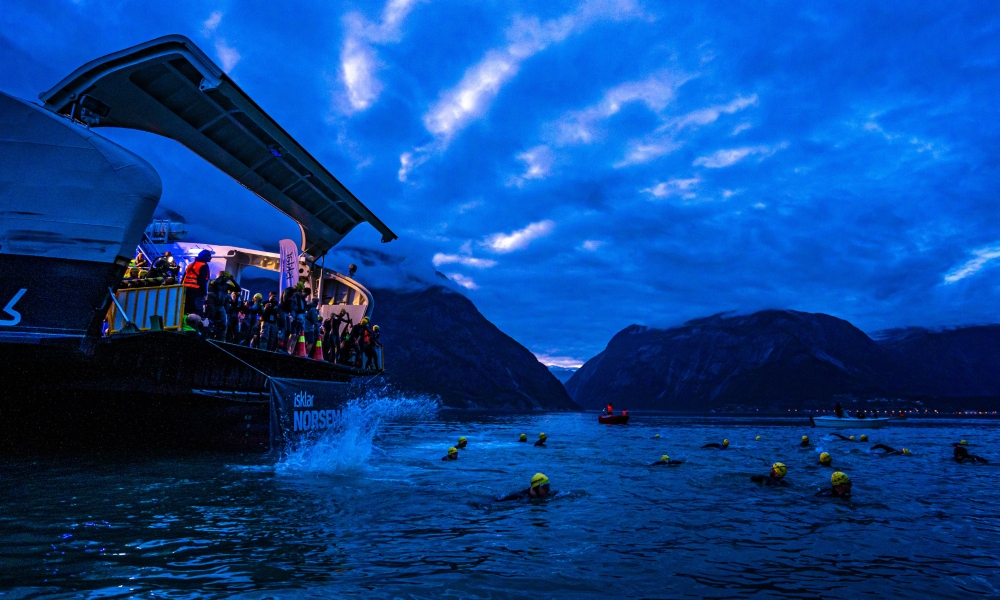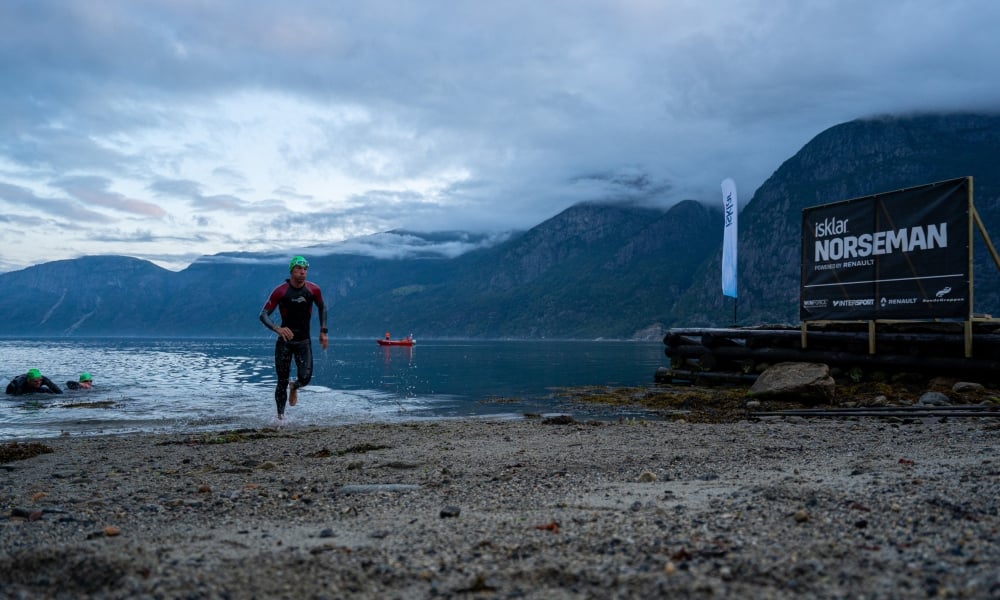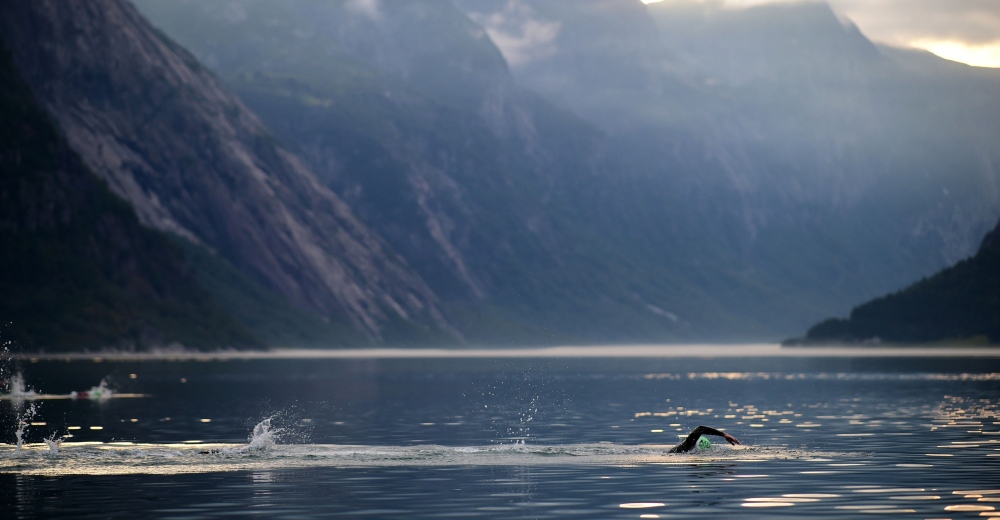With public swimming pools closed in many countries, swimming in open water ensures we keep our training moving forward. However, open water is usually colder water, especially earlier in the year.
We talked to Norseman Xtreme Triathlon chief medical and safety officer Jørgen Melau about how to stay safe swimming in cold water. Jorgen is currently finishing a PhD on cold water swimming and before starting his research he served in Norway’s Arctic air ambulance rescue operations.
“There are many benefits to cold water swimming,” Jørgen says “And although our research is focused on the dangers, I want to stress that the benefits of open water swimming far outweigh the risks. So I really encourage everyone to try it!”

Joakim Dokka Nordstad/nxtri.com
The benefits
Ask any dedicated cold water swimmer and they will tell you how amazing it makes them feel. This is probably because of the massive endorphin (feel good hormones) release swimming in cold water generates. Plunging into uncomfortably cold water stimulates our body’s pain system, which releases those delightful endorphins to help us manage it.
Cold water swimming is also touted to improve circulation, burn more calories, increase libido, reduce stress and strengthen the immune system.
The risks
When you suddenly enter cold water it strongly activates several branches of the nervous system. “These are strong and powerful activations, and for some vulnerable people, it can be very dangerous because it can generate arrhythmias,” Jørgen says. “It is called the autonomic conflict, if anyone is interested in learning more.”
The second risk is hypothermia, due to the cooling of the body’s core temperature. “Hypothermia is a problem only if the water is cold and the swim is very long,” Jørgen explains. “However, there are huge individual variations, and this is why it is so hard to give any exact limits. We do not recommend swimming in water colder than 12°C. And for some, it should probably be much warmer.”
Study demonstrates risk
In the 2015 Norseman Xtreme Triathlon the water temperature dropped to 10°C so Jørgen and the race organisers shortened the swim. A few months later Jorgen asked 20 triathletes to swim in 10°C water for a controlled study. The study showed that if Norseman had allowed a full distance swim in 2015, almost 50% of the athletes would have suffered from medical hypothermia. “This was a real eye opener, and something we believe is very important to know,” Jørgen says.
How to begin
Start with brief sessions
To give your body and mind time to adapt, start cold water swimming with brief sessions. Then as you become accustomed, you can gradually lengthen them.
Enter the water gradually
Jørgen advises not to jump or dive into cold water, but to enter gradually. “The human body is very adaptable to different environments. Yet, we help ourself a lot if we give the body some time to readjust. Enter the water slowly, taking half a minute to a minute.”
Stay active after
After exiting the water, stay active to warm up your body. “Your body is excellent in producing its own heat, and you do that by keeping your muscles busy,” Jørgen says. “So go for a run or hop onto the bike. “An additional tip is to dry off your wet skin when you have finished your swim; you waste a lot of heat if the body needs to dry your skin from its internal heat supply.”

Joakim Dokka Nordstad/nxtri.com
The Norseman open and cold water swimming code
Never swim alone
This really is essential. Before embracing adventure and bracing for the cold you need to find a buddy to share the journey to help keep one another safe. Alternatively, you can find someone to monitor your progress from a boat or by the shore.
Out on swims together, stay close and be observant of your swim buddy. If you swim in a group, always team up with a buddy, so you can look out for each other. It’s safer and more fun.
Avoid water colder than 12°C
Norseman advises people 12°C should be the minimum for cold water wetsuit swims. And for such low temperatures, the swims should be short.
“For many people, it’s probably wise to have a higher water temperature than this,” Jorgen cautions.
If you feel cold for more than 10 minutes, abort the swim, and get yourself warm. Be aware that the temperature and wind on land may pose a risk for hypothermia even after exiting the water.
In cold water, swim for 20 minutes only before exiting the water to warm up.
Plan your swim
Cold water swimming is a little like going up into an alpine environment in the sense you shouldn’t just wing it, and hope everything will be hunky dory. It’s asking for trouble
Research your swimming spot. Be aware of hazards like shallow water, tides, rip currents, marine life, or boat traffic. With Suunto App, use Suunto Heatmaps to find places to swim and ask people in the Suunto community who swim there for info.
Let someone at home know where you plan to swim and what time you will finish.
Check the weather forecast.
Know your ability
To stay safe and to keep it enjoyable, make sure you have the ability and fitness to complete the swim you’ve planned. Keep an eye on the conditions; a wind change can quickly increase wave or swell size.
Under no circumstances go swimming during a thunderstorm. A lightning strike in water may be lethal.
Swim close to shore
If the conditions change or you get tired or start getting cramps, being close to shore means you can get out quickly. You are also easier to spot and help close to shore, and you avoid encountering potentially dangerous marine traffic.
Be prepared for emergencies
Have a plan in mind for what to do if anything happens to you or your swim buddy. Know exactly where the nearest phone (your swim tow, the car). Consider having a third person observing you both from shore. If there are known rips or currents in the area, know how to respond if you get caught in one. Where are alternative exit points?

Alexander Koerner/nxtri.com
Get emergency training
Practice how to help your buddies in open water, transiting him or her to shore, and getting them out of the water. This is important to know in the eventuality your buddy cramps.
Know your CPR and take a course regularly to maintain your knowledge.
Have the right gear
A Suunto watch paired with a Suunto Smart Sensor heart rate belt: These track your level of exertion, give you data about your stroke rate, time and distance, and the GPS will allow you to see post-swim whether you swam in a straight line or not. Plus, Suunto Heatmaps makes it easy to find popular open water swimming spots near you.
- A swim tow float: these are an extra safety aid. They act as a flotation device in the event you get cramp or need to rest. They are brightly coloured so improve your visibility and can be used to store your car keys, wallet and smartphone.
- A silicone hat or wetsuit hood. Try to find a brightly coloured hat so you are easily visible on the surface.
- Goggles: Make sure they are comfortable to wear for an extended period and consider choosing polarized goggles to reduce sun glare for better vision.
- Anti chafe balm: applying this under your wetsuit helps to prevent chafed and cracked skin.
- Boots, gloves, wetsuit socks: these not only keep your feet and hands warm, they also prevent injury by providing some grip as you enter and exit the water.
Lead images: Alexander Koerner/nxtri.com
Read more articles
10 reasons to enjoy open water simming with Suunto
5 steps to therapeutic breathing to combat COVID-19